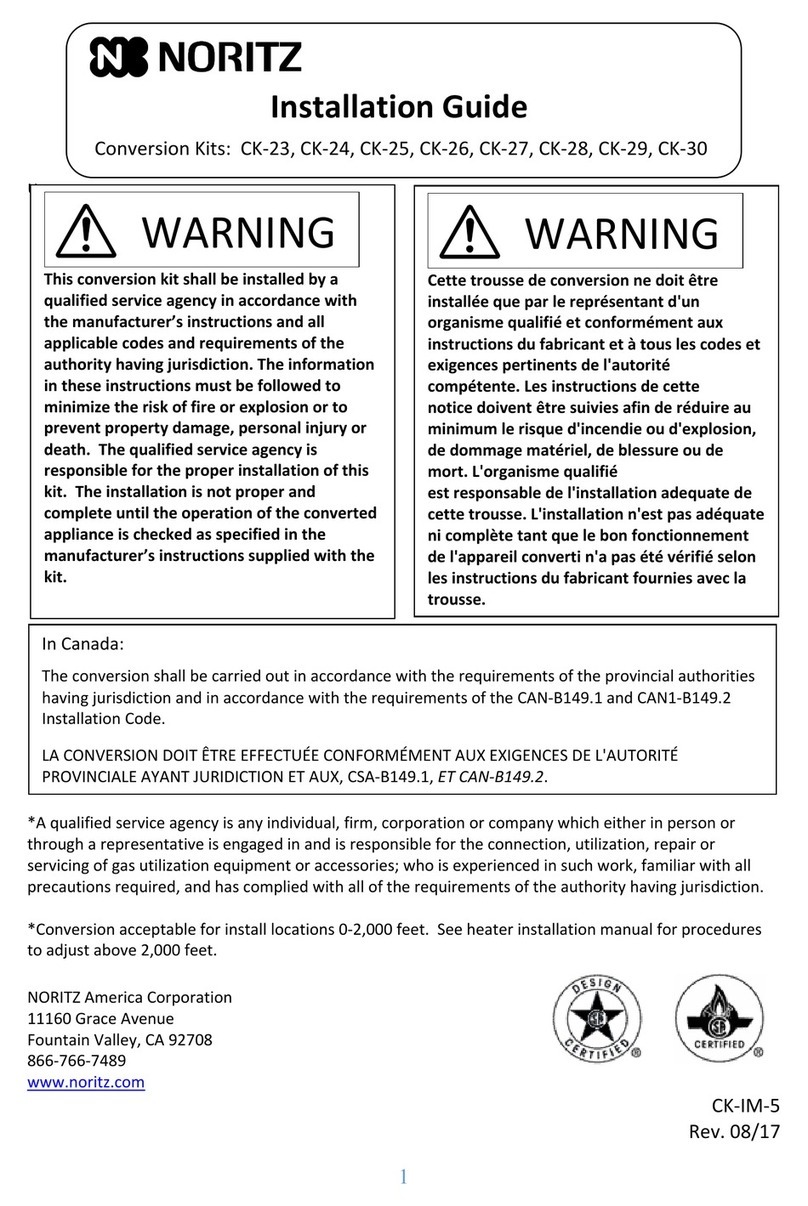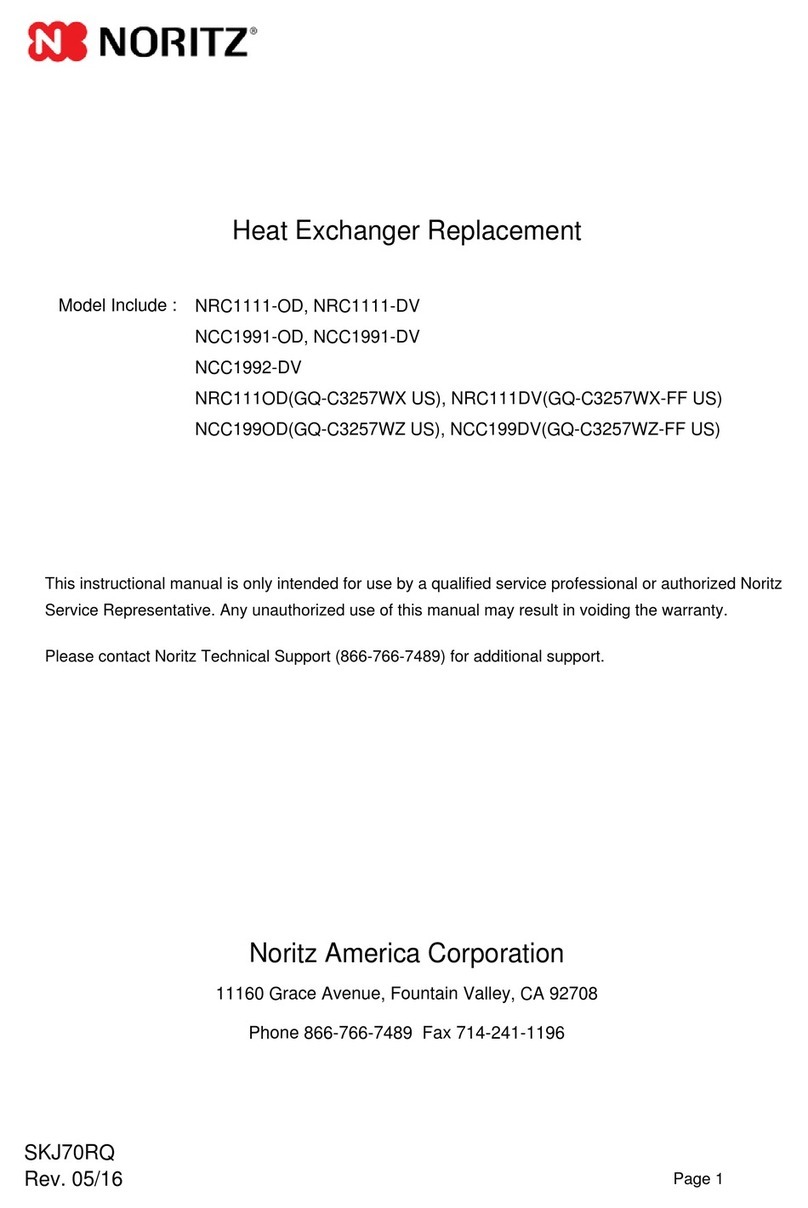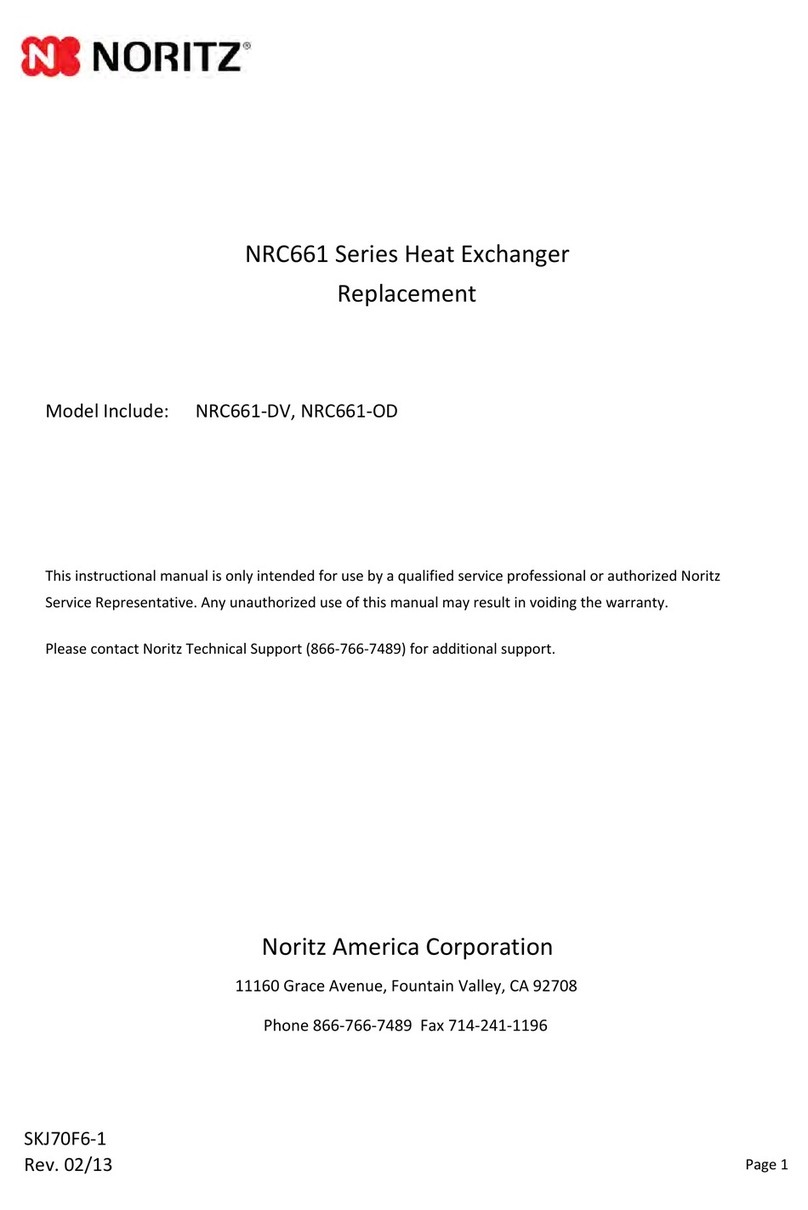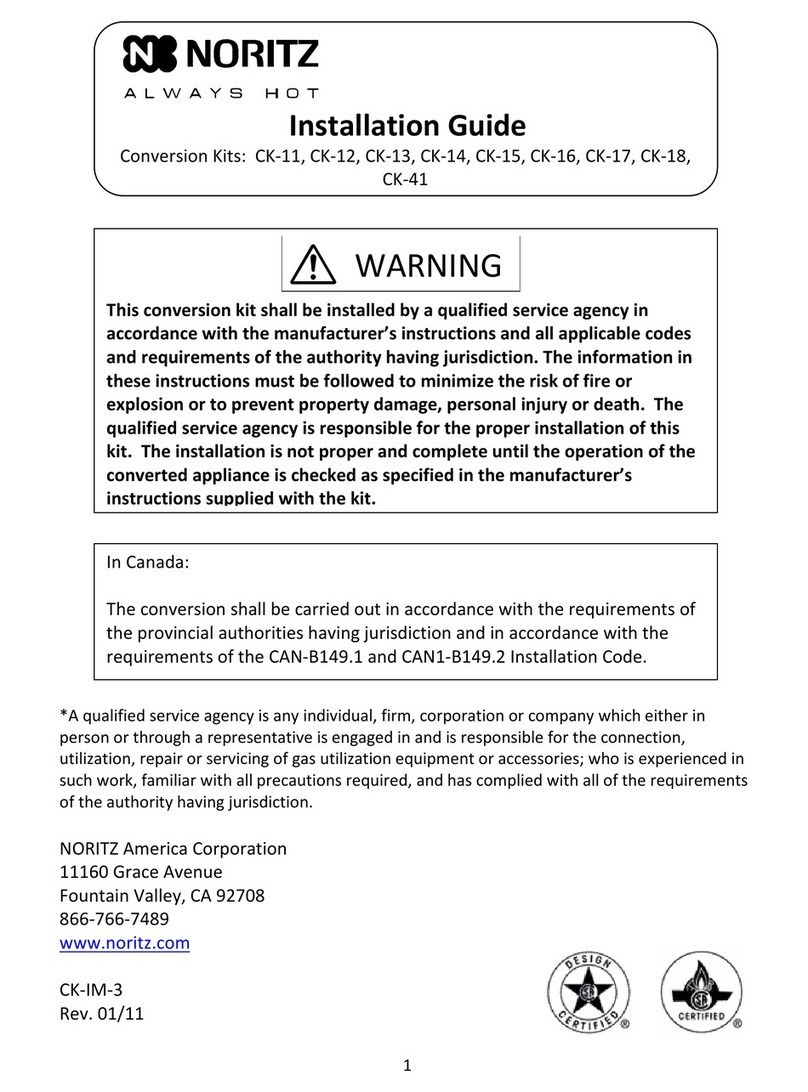Noritz CK-19 User manual

1
This conversion kit shall be installed by a qualified service agency in
accordance with the manufacturer’s instructions and all applicable codes
and requirements of the authority having jurisdiction. The information in
these instructions must be followed to minimize the risk of fire or
explosion or to prevent property damage, personal injury or death. The
qualified service agency is responsible for the proper installation of this
kit. The installation is not proper and complete until the operation of the
converted appliance is checked as specified in the manufacturer’s
instructions supplied with the kit.
In Canada:
The conversion shall be carried out in accordance with the requirements of
the provincial authorities having jurisdiction and in accordance with the
requirements of the CAN- 149.1 and CAN1- 149.2 Installation Code.
*A qualified service agency is any individual, firm, corporation or company which either in
person or through a representative is engaged in and is responsible for the connection,
utilization, repair or servicing of gas utilization equipment or accessories; who is experienced in
such work, familiar with all precautions required, and has complied with all of the requirements
of the authority having jurisdiction.
NORITZ America Corporation
11160 Grace Avenue
Fountain Valley, CA 92708
866-766-7489
www.noritz.com
CK-IM-3
Rev. 12/09
nstallation Guide
Conversion Kits:
CK
-
19
,
CK
-
20,
CK
-
21, CK
-
22
WARNING

2
1. Before Conversion
efore attempting to convert a unit, verify that the proper kit has been purchased for the model
type*:
Conversion Kit Model Conversion Type
CK-19 N-0841MC/NCC199-
SV,
N-0842MC/NRC111-SV Propane to Natural Gas
CK-20 N-0841MC/NCC199-
SV,
N-0842MC/NRC111-SV Natural Gas to Propane
CK-21 N-0841MC-DV/NCC199-SV,
N-0842MC-DV/NRC111-SV Propane to Natural Gas
CK-22 N-0841MC-DV/NCC199-SV,
N-0842MC-DV/NRC111-SV Natural Gas to Propane
*The model type can be verified from the rating plate located on the front cover of the water
heater.
Tools Required:
•Noritz Remote Controller (RC-7649M)
•Manometer (Capable of displaying digits in tenths (i.e. 2.4) and up to 20” W.C.)
•Philips screwdriver (#2 Recommended)
•Pliers
•Gas leakage device detector
NOTE: Do not attempt to perform a conversion without access to a manometer and a Noritz
remote controller. A digital manometer is recommended.

3
2. ncluded Parts
The following parts are supplied in the
conversion kit. Check for any missing
items before starting the conversion.
3. Conversion Procedure
Parts
Shape
Quantity
Manifold Plate
1
O-Ring
2
Main Damper
(N-0841MC/NCC199-SV, N-
0842MC/NRC111-SV and -DV
NG/LPG only)
1
New Inlet and Manifold Pressure
Rating Sticker
1
Date, Gas Type, Kit Number, Name of
Company Sticker
1
Parts Replacement:
1) If the display on the remote controller is on, turn off the unit by pressing the “ON/OFF”
button on the remote controller. There should be no display on the remote controller.
2) Turn off electrical power to heater by
disconnecting the electrical plug from the outlet
or shut off the breaker providing power to
water heater.
3) Turn off the gas supply to the water heater by
closing the gas shut-off valve.
4) Remove the front cover of the unit by
removing the 4 screws holding it to the
case.

4
Gas Pipe
F GURE 1
F GURE 2
5) Locate the six colored wire connectors (Gray, lack, Orange, White, lue, and Red) from
the electrical solenoids on the manifold from the locations indicated in Figure 1 on the
following page. Follow the wires to a white clip and disconnect it. Disconnect the gas
pipe from the gas supply inlet by removing the C-Clamp at the bottom of the gas pipe
(Figure 2). For easier access remove the mounting plate with the current leakage safety
device in front of the gas pipe.
6) Then locate and remove the 4 screws with a Philips screwdriver (Figure 1). Do NOT use
a power drill. Once screws are removed, pull the gas pipe from the gas fitting. When
the pipe and manifold have been detached, remove the gas pipe from the manifold inlet.
Remember to remove the manifold screw. This will be used on the new manifold
plate. Discard the original manifold plate.
GRAY BLACK ORANGE
BLUE RED
WH TE
(BACK)
O
-
Ring
Gas Pipe
C-Clamp
Disconnect White Clip
Remove
Manifold
Screw

5
7) FOR N-0841MC NG/LPG and N-0841M-DV NG/LPG ONLY: After manifold plate is
removed, the existing damper will be exposed as indicated in Figure 3 below. Remove
screws (1), (2), (3), and then pull the damper off the burner assembly. Check for proper
size of damper with the chart below and replace with new damper that was included
with your gas conversion kit.
F GURE 3
8) Locate the black O-rings on the gas pipe as indicated in
Figure 2 & 4. If torn or damaged, remove and replace O-
rings with the new O-rings supplied in the conversion kit.
Discard the old O-rings.
9) Insert the new manifold plate supplied with the
conversion kit. The orifice size of the gas manifold plate
should be marked as follows (check Figure 5):
N-0841MC/NCC199-SV, N-0841MC-DV/NCC199-DV, N-0842MC
/NRC111-SV, and N-0842MC-DV/NRC111-DV:
•To fire Natural Gas (NG) – 3.6
•To fire Propane Gas (LPG) – 2.3
F GURE 5
DO NOT continue with conversion if manifold plate is incorrect.
Model Name Gas
Conversion Damper Size
N-0841MC
/NCC199-SV,
N-0842MC
/NR111-SV
NG to LPG 9-10
LPG to NG 9-10A
N-0841MC-DV
/NCC199-DV,
N-0842MC-DV
/NRC111-DV
NG to LPG 11
LPG to NG 9-10
(Ex: 13 = N-0751M-NG)

6
10) Make sure that the O-Ring is secured properly in place. Failure to do so will cause gas
leaks, possibly resulting in severe personal injury or death.
11) Once O-ring is in place, slide the gas pipe into the manifold inlet. Make sure that the gas
pipe is completely inserted into the manifold inlet in order to prevent any gas from
leaking.
12) Insert gas pipe into the gas supply inlet and hold the manifold plate in place.
13) Secure the new manifold plate to the unit using the screws removed in Step 7. The
screws need only to be hand tightened and should not be tightened using a drill. First,
insert screws 1-4 from Figure 1, but do not fully tighten these screws. Once all screws
are inserted, proceed to completely tighten screws 1-4.
Note: When tightening the screws, be certain to not apply excess force as the screws should
turn easily. If extra force is required, stop, remove the screw and tighten by hand first. Excess
force can strip out the original holes.
14) Attach C-Clamp at the bottom of the gas pipe (Figure 2). Failure to do so will cause gas
leaks, possibly resulting in severe personal injury or death.
15) Reconnect the white clip that contains the wires to the electrical solenoids on the
manifold from the locations indicated in Figure 1.
16) efore replacing the front cover, the unit must be adjusted and tested as described in
the next section.
Adjustments:
1) efore electrical power is applied to the unit, install a remote controller to the unit if it
is not already installed.
2) Reconnect the electrical power to the unit.
3) Within the first ten minutes of connecting electrical power to the unit, but before
pressing the Power ON/OFF button (display should be blank), hold the up button on the
remote controller until the display blinks “99”. This will put the unit into Maintenance
Writer mode. If pressing the up button does not put the unit into Maintenance Writer
mode, make sure the remote display is blank, unplug the unit for sixty seconds, and try
again.

7
4) After accessing the Maintenance Writer mode, use the “up” and “down” buttons to
change the Maintenance Writer item number display. Pressing the “FLOW METER
ALARM SET” button for 0.5 seconds will change the item number setting from “ON” to
“OFF”. If the Priority lamp is flashing when an item number is displayed, this indicates an
“ON” setting for that item number, and if the Priority lamp is off, the item number is
“OFF”.
5) Change “FC” and “FE” from OFF to ON. The priority light should be flashing on both item
numbers after pressing the “FLOW METER ALARM SET”.
6) Choose the proper conversion setting from the chart below and set the “A1”
Maintenance Writer item number according to the chart below.
Note: DO NOT change the other item numbers. This will cause a fault in the water heater.
ON: “Priority” light is
flashing.
OFF: “Priority” light is off.
7) After setting the “A1” item number for the desired gas type, press and hold the “up”
and “down” buttons together for five seconds to confirm the new settings. The remote
controller will emit a tone and the display will go blank when the settings are confirmed.
If this is not done, the unit will not put the setting changes into effect.
Note: The setting changes can be cancelled by pressing the Power ON/OFF button
before confirming the settings, or if the unit is left alone for ten minutes without
confirming the settings. If the default setting needs to be changed again, disconnect the
electrical power to the unit, reconnect it and repeat this procedure.
Testing:
1) efore turning on the gas supply to the unit, verify that the inlet gas supply pressure is
within the following operating ranges:
a. Natural Gas Supply: Min. 4 – Max. 10.5 inches
b. Propane Supply: Min. 8 – Max. 14 inches
Models Desired Gas Type A1
N-0841MC/NCC199-SV,
N-0841MC-DV/NCC199-
DV,
N-0842MC/NRC111-SV,
N-0842MC-DV/NRC111-DV
Natural Gas ON
N-0841MC/NCC199-
SV,
N-0841MC-DV/NCC199-
DV,
N-0842MC/NRC111-
SV,
N-0842MC-DV/NRC111-DV
Propane OFF

8
Note: If the supply pressure is higher that the maximum allowable pressure, adjust the pressure
at the regulator or install a secondary regulator on the supply line connected to the water
heater. DO NOT attempt to operate heater if gas supply pressure is not within ranges
specified above. High supply pressure can damage the unit and possibly cause a gas leak.
Next, verify the supply pressure at the unit. To check the gas supply pressure to the unit, a tap
is provided on the gas inlet (Figure 7). Make sure gas supply is turned off to the unit. Remove
the hex head Philips screw from the tap. A 9/32” nut driver is recommended for the removal of
this screw. If a nut driver is not available, a Philips screwdriver can be used. Gently remove the
screw, so as not to strip out the screw.
2) Connect a manometer to the tap by using a
silicone tube. Turn on gas supply to unit and
confirm the supply pressure.
3) After supply pressure to heater has been
confirmed, turn off the gas supply, remove the
manometer tube and replace the hex head screw.
4) The manifold pressure will also have to be checked
using a manometer (digital manometer is
suggested). In order to check the gas manifold
pressure, a tap is provided on the manifold plate
inside the unit (Figure 8). The pressure can be
checked either by removing the Philips head screw
(1) and connecting a manometer with a silicon
tube, or by removing the 1/8” NPT screw (2) with
an Allen wrench and connecting the appropriate
pressure gauge. e sure to zero out the
manometer before attaching it to the tap.
5) Turn on the gas supply to the unit.
6) efore firing the unit, check for gas leaks at the gas inlet fitting and around the manifold
plate using a gas leak detection device.
7) If not already on, press the Power “ON/OFF” button so that the unit is in standby mode.
The priority light should be on.
8) Open up several hot water fixtures (high flow rate is required through the unit) and
allow the unit to go through its startup sequence. It may take several ignition attempts
in order to purge air from the gas chambers. If an “11” code appears on the remote
controller, reset the unit by pressing the Power button on the remote controller off and
then on again.
F
GURE
7
F
GURE
8

9
F GURE 10
9) Once the heater has ignited and has begun to run
continuously, locate the manifold adjustment buttons
on the right side of the circuit board (Figure 9). Check
directly below the manifold adjustment buttons for a
label in order to identify the type i.e. ELV, ELV-A, ELW,
etc.
10) Press and hold the maximum pressure set button.
Verify from the tables below that the appropriate
pressure is read from the manometer. If the pressure
needs adjustment, use the manifold pressure increase
and decrease buttons to adjust to the correct
pressure, while continuing to hold down the
maximum pressure set button.
11) Press and hold the minimum pressure set button.
Verify from the tables on the following page that the
appropriate pressure is read from the manometer. If
the pressure needs adjustment, use the manifold
pressure increase and decrease buttons to adjust to
the correct pressure, while continuing to hold down
the minimum pressure set button.
F GURE 9
Manifold Gas Pressure Maximum and Minimum Values
After the manifold pressures have been confirmed,
verify that the flame is a steady blue color using the
inspection window (Figure 10).
12) Turn off water and gas to unit. Replace screw from
manifold tap and turn gas back on to unit.
13) Perform a final gas leak check around the entire
manifold plate, especially near the gas pipe and
manifold inlet, using a gas leak detection device.
Model Name Gas Type Supply Pressure
(inch H2O)
Manifold Pressure (inch H
2
O) Cover Off
Max Value Min Value
N-0841MC
/NCC199-SV
N-0842MC
/NRC111-SV
NGA 7.9 3.43 0.92
LPG 11.0 4.33 1.04
N-0841MC-DV
/NCC199-DV
N-0842MC-DV
/NRC111-DV
NGA 7.9 3.66 0.96
LPG 11.0 4.70 1.12

10
14) If the remote controller needs to be removed,
disconnect electrical power to heater and proceed
to remove controller connections.
Apply conversion labels:
1) Replace the front cover of the unit using the 4 screws previously removed.
2) Locate the 2 conversion stickers supplied in the conversion kit.
3) Place the sticker indicating the new inlet and manifold pressures directly above the
rating sticker so as not to cover any existing markings as indicated by “A” in Figure 11.
4) Fill out the required information on the remaining sticker indicating the date, gas type,
kit number, and name of the company performing the conversion. Place this sticker on
the front cover as indicated by “ ” in Figure 11. Do not to cover any existing markings.
(N-0842MC/NRC111-SV) (N-0842MC-DV/NRC111-DV)
(N-0841MC/NCC199-SV & N-0841MC-DV/NCC199-DV on Right Side of Case)
F GURE 11

11
nstallation Checklist:
Parts Replacement:
□Remove existing manifold plate, main damper, and O-ring. (Model N-0751M-OD does
not have a main damper.) Discard these parts.
□Replace with new manifold plate, main damper, and O-ring. (Model N-0751M-DVC-NG
will need a new exhaust ring.)
□Make sure that manifold plate, main damper, and O-ring are securely in place.
Adjustments:
□Access Maintenance Writer mode and set the A1 item number to desired gas type.
□Confirm gas type settings.
Testing:
□efore opening gas valve to heater, verify that gas supply pressure is within operating
range of heater.
□If gas supply pressure is not within specification, adjust the pressure at the regulator or
install a secondary regulator on the supply line connected to the water heater.
□Remove hex Philips screw from inlet of Noritz heater and confirm gas supply pressure at
unit with manometer. Replace screw after confirmation of gas supply pressure.
□Remove hex Philips screw or 1/8” NPT screw from gas valve and connect manometer to
gas valve.
□Check for gas leaks around gas inlet fitting and manifold plate using a gas leak detection
device.
□Check and confirm correct manifold pressures. Make adjustments if necessary. Replace
screw after manifold pressures have been confirmed.
□Perform final gas leak check again with gas leak detection device.
Apply Conversion Labels:
□Place New Inlet and Manifold Pressure Rating Sticker above rating sticker on front cover.
□Fill out information on Date, Gas Type, Kit Number, Name of Company Sticker and place
on front cover.
This manual suits for next models
3
Table of contents
Other Noritz Industrial Equipment manuals
























